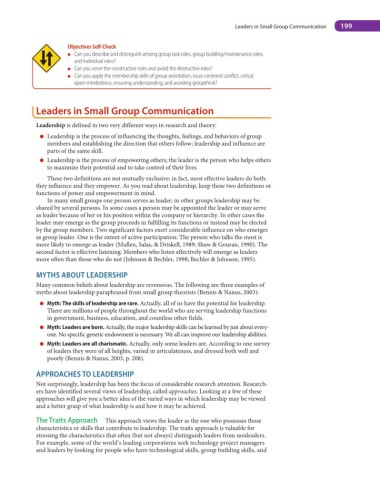Page 220 - Essentials of Human Communication
P. 220
Leaders in Small Group Communication 199
Objectives self-Check
● Can you describe and distinguish among group task roles, group building/maintenance roles,
and individual roles?
● Can you serve the constructive roles and avoid the destructive roles?
● Can you apply the membership skills of group orientation, issue-centered conflict, critical
open-mindedness, ensuring understanding, and avoiding groupthink?
Leaders in small Group Communication
Leadership is defined in two very different ways in research and theory:
● Leadership is the process of influencing the thoughts, feelings, and behaviors of group
members and establishing the direction that others follow; leadership and influence are
parts of the same skill.
● Leadership is the process of empowering others; the leader is the person who helps others
to maximize their potential and to take control of their lives.
These two definitions are not mutually exclusive; in fact, most effective leaders do both:
they influence and they empower. As you read about leadership, keep these two definitions or
functions of power and empowerment in mind.
In many small groups one person serves as leader; in other groups leadership may be
shared by several persons. In some cases a person may be appointed the leader or may serve
as leader because of her or his position within the company or hierarchy. In other cases the
leader may emerge as the group proceeds in fulfilling its functions or instead may be elected
by the group members. Two significant factors exert considerable influence on who emerges
as group leader. One is the extent of active participation: The person who talks the most is
more likely to emerge as leader (Mullen, Salas, & Driskell, 1989; Shaw & Gouran, 1990). The
second factor is effective listening: Members who listen effectively will emerge as leaders
more often than those who do not (Johnson & Bechler, 1998; Bechler & Johnson, 1995).
MYtHs abOut leadersHIP
Many common beliefs about leadership are erroneous. The following are three examples of
myths about leadership paraphrased from small group theorists (Bennis & Nanus, 2003):
● Myth: The skills of leadership are rare. Actually, all of us have the potential for leadership.
There are millions of people throughout the world who are serving leadership functions
in government, business, education, and countless other fields.
● Myth: leaders are born. Actually, the major leadership skills can be learned by just about every-
one. No specific genetic endowment is necessary. We all can improve our leadership abilities.
● Myth: leaders are all charismatic. Actually, only some leaders are. According to one survey
of leaders they were of all heights, varied in articulateness, and dressed both well and
poorly (Bennis & Nanus, 2003, p. 208).
aPPrOaCHes tO leadersHIP
Not surprisingly, leadership has been the focus of considerable research attention. Research-
ers have identified several views of leadership, called approaches. Looking at a few of these
approaches will give you a better idea of the varied ways in which leadership may be viewed
and a better grasp of what leadership is and how it may be achieved.
the traits approach This approach views the leader as the one who possesses those
characteristics or skills that contribute to leadership. The traits approach is valuable for
stressing the characteristics that often (but not always) distinguish leaders from nonleaders.
For example, some of the world’s leading corporations seek technology project managers
and leaders by looking for people who have technological skills, group building skills, and

